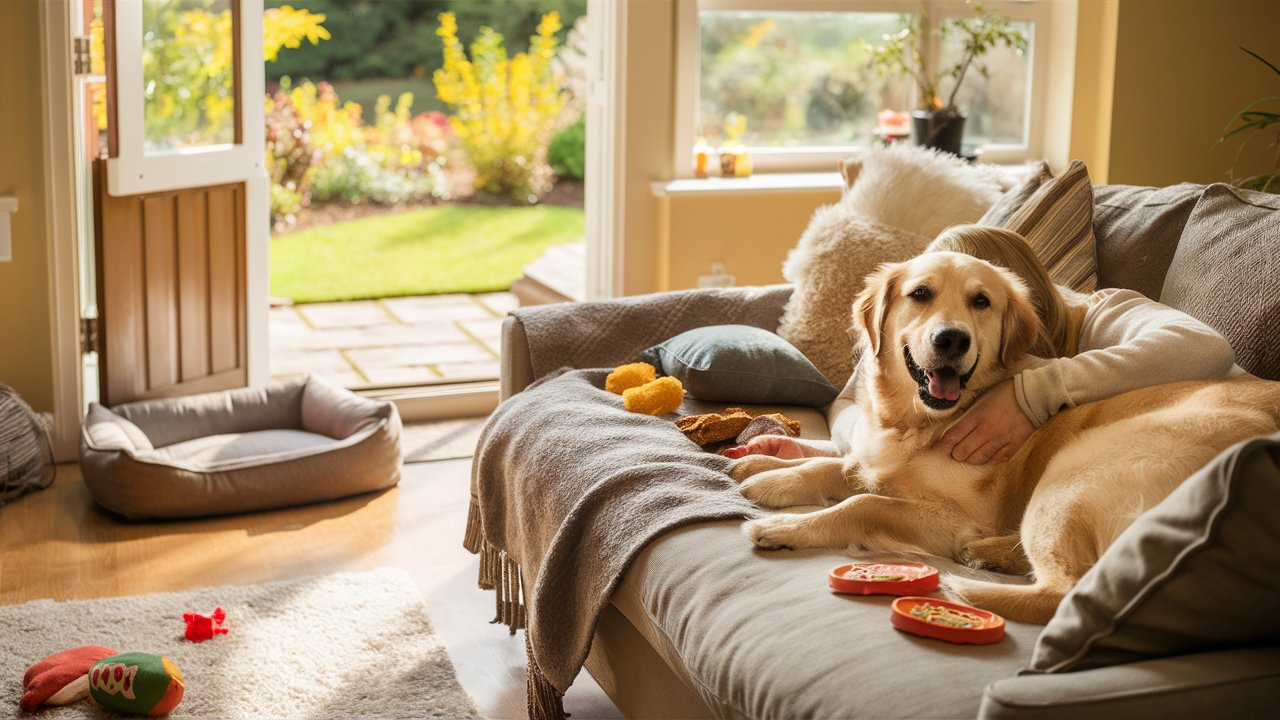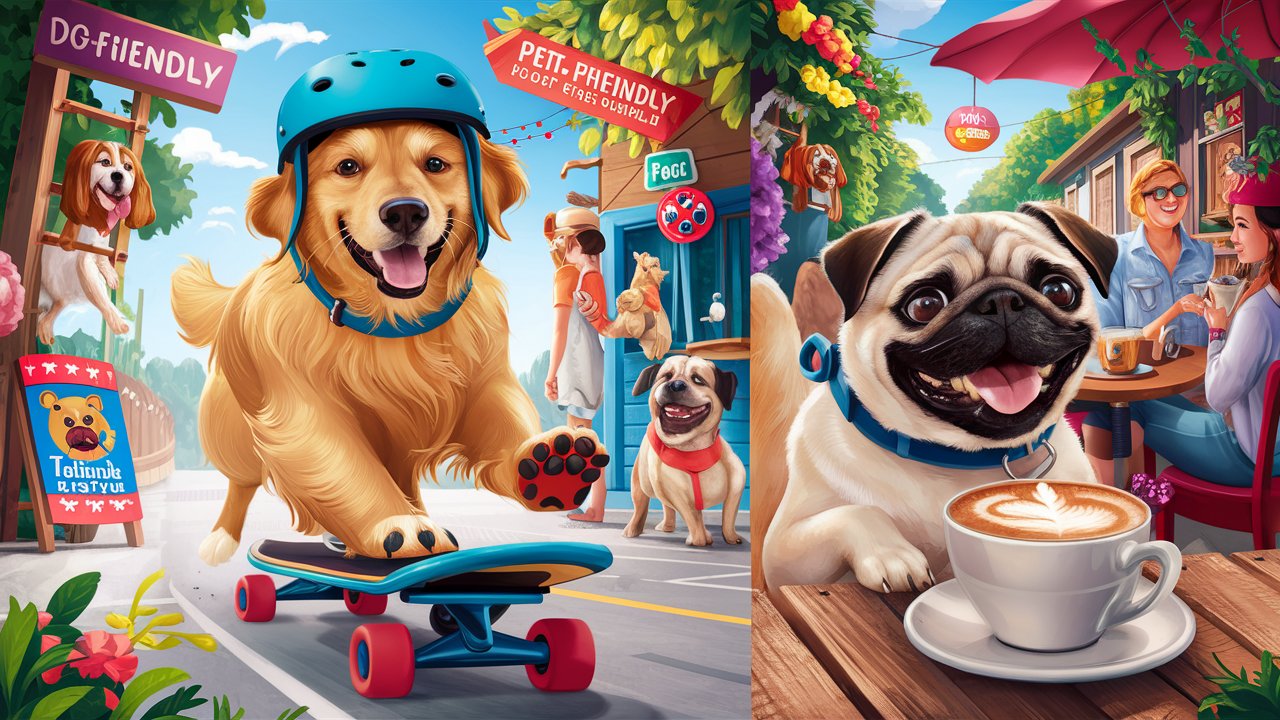Creating a Perfect Dog-Friendly Lifestyle 100% Ultimate Guide
Dogs are more than just pets; they’re family members, loyal companions, and sources of unconditional love. For many dog owners, integrating their furry friends into daily life is a priority. From finding dog-friendly restaurants to planning vacations that include your canine companion, embracing a dog-friendly lifestyle can enhance your bond and create unforgettable memories. In this article, we’ll explore tips, destinations, and personal stories that highlight the joys and challenges of living a dog-friendly life.
Why a Dog-Friendly Lifestyle Matters

Creating a dog-friendly lifestyle is not just about accommodating your pet; it’s about enhancing the quality of life for both you and your canine companion. This approach acknowledges the deep bond between humans and dogs and seeks to nurture it through thoughtful integration of pets into various aspects of daily living. Here’s why a dog-friendly lifestyle matters:
1. Strengthening the Human-Animal Bond
Dogs are social animals that thrive on companionship. By adopting a dog-friendly lifestyle, you foster a stronger bond with your pet, which is beneficial for both parties. This bond is characterized by mutual trust, love, and understanding, and it contributes to a happier and more harmonious household.
Personal Anecdote: I recall the first time I took my Beagle, Rocky, on a camping trip. The experience of exploring nature together and sharing the adventure significantly deepened our bond. It was clear that these shared experiences enriched our relationship in ways that staying at home could not.
2. Dog-Friendly Lifestyle Improving Physical Health
Dogs require regular exercise to stay healthy, and this need can motivate owners to lead a more active lifestyle. Daily walks, hikes, and playtime are great ways to keep both you and your dog fit. Regular physical activity can reduce the risk of various health issues, including obesity, heart disease, and joint problems.
Health Benefits for Dogs:
- Maintains a healthy weight
- Strengthens muscles and joints
- Improves cardiovascular health
Health Benefits for Humans:
- Increases cardiovascular fitness
- Reduces stress and anxiety
- Enhances overall physical fitness
3. Enhancing Mental Well-Being
Spending time with dogs has been shown to reduce stress, anxiety, and depression. The act of petting a dog releases oxytocin, a hormone that promotes feelings of relaxation and bonding. Additionally, dogs provide a sense of purpose and routine, which can be especially beneficial for individuals dealing with mental health issues.
Personal Anecdote: During a particularly stressful period at work, having my Labrador, Bella, around was incredibly soothing. Her presence provided a calming effect, and taking breaks to play with her helped me manage my stress levels better.
4. Promoting Social Interaction
Dogs are great icebreakers and can help you meet new people. Dog parks, pet-friendly events, and training classes provide opportunities to socialize with other dog owners, fostering a sense of community. These interactions can lead to lasting friendships and support networks.
5. Creating a Safe and Stimulating Environment
A dog-friendly lifestyle involves creating an environment that is both safe and stimulating for your pet. This includes providing a variety of toys, activities, and social interactions that cater to your dog’s needs and natural instincts. A well-stimulated dog is less likely to engage in destructive behaviors born out of boredom or anxiety.
6. Encouraging Responsible Pet Ownership
Adopting a dog-friendly lifestyle encourages responsible pet ownership. This means being attentive to your dog’s needs, such as regular veterinary check-ups, proper nutrition, and grooming. It also involves training and socializing your dog to ensure they are well-behaved and comfortable in various settings.
7. Supporting Community Well-Being
A dog-friendly lifestyle extends beyond the home. It contributes to the overall well-being of the community by promoting responsible pet ownership and encouraging pet-friendly policies in public spaces. This can lead to cleaner parks, safer streets, and more inclusive social environments.
Examples of Community Benefits:
- Cleaner public spaces due to responsible pet waste management
- Increased community engagement through pet-friendly events
- Enhanced safety through well-socialized and trained dogs
8. Economic Benefits
Embracing a dog-friendly lifestyle can also have economic benefits. Pet-related businesses, such as pet-friendly hotels, restaurants, and retail stores, can thrive in communities that welcome dogs. This can stimulate local economies and create job opportunities.
9. Educational Opportunities
Living with a dog provides numerous opportunities for education. It can teach children and adults alike about responsibility, empathy, and the importance of animal welfare. Schools and community programs that incorporate pet care education can foster a culture of kindness and respect towards animals.
10. Advancing Pet-Friendly Policies
Advocating for a dog-friendly lifestyle can lead to positive changes in local policies and regulations. This includes the creation of more dog parks, pet-friendly housing options, and public transportation accommodations. Such advancements benefit not only dog owners but also the broader community by creating a more inclusive environment.
Finding Dog-Friendly Places

Creating a dog-friendly lifestyle involves integrating your furry friend into various aspects of your life, including travel, dining, and outdoor activities. This section will guide you through the process of finding dog-friendly places, ensuring you and your dog can enjoy adventures together without any hassle.
1. Researching Dog-Friendly Locations
When planning outings or trips with your dog, the first step is to research dog-friendly locations. Here are some tips on how to find these places:
Online Resources
- Websites and Apps: Websites like BringFido, DogFriendly, and PetFriendlyTravel offer comprehensive databases of dog-friendly hotels, restaurants, parks, and attractions. Apps like Rover and AllTrails can help you find dog-friendly trails and services.
- Social Media: Join local dog groups on platforms like Facebook or Reddit. Members often share recommendations and experiences about dog-friendly places.
- Travel Blogs: Many travel bloggers specialize in pet-friendly travel and provide detailed guides and reviews of destinations.
Local Resources
- Veterinary Clinics: Your vet can be a valuable source of information on local dog-friendly spots.
- Pet Stores: Employees at pet stores often know the best dog-friendly areas in the community.
- Dog Trainers and Groomers: Professionals in the pet industry can offer insights into dog-friendly businesses and parks.
2. Dog-Friendly Restaurants and Cafes
Dining out with your dog can be a delightful experience. Many restaurants and cafes now offer dog-friendly patios and even special menus for dogs. Here’s how to find and enjoy these places:
Finding Dog-Friendly Eateries
- Check Online Reviews: Websites like Yelp and TripAdvisor often have filters for dog-friendly establishments. Look for reviews that mention dogs or have photos of dogs at the venue.
- Call Ahead: Even if a restaurant is listed as dog-friendly, it’s a good idea to call and confirm their pet policy, especially during peak hours or seasons.
Etiquette for Dining with Dogs
- Leash and Control: Keep your dog on a leash and under control at all times. Ensure they are well-behaved and do not disturb other diners.
- Bring Essentials: Carry a portable water bowl, some treats, and waste bags. Some restaurants may offer water bowls, but it’s best to be prepared.
- Respect the Space: Keep your dog close to you and avoid blocking pathways or entrances.
3. Dog-Friendly Hotels and Lodging
Traveling with your dog requires finding pet-friendly accommodations. Many hotels, motels, and vacation rentals now welcome dogs, but policies can vary widely.
Finding Pet-Friendly Lodging
- Booking Websites: Use filters on booking websites like Expedia, Booking.com, and Airbnb to find pet-friendly accommodations. Check the property’s pet policy for details on fees, size limits, and amenities.
- Pet-Friendly Chains: Some hotel chains, like La Quinta, Kimpton Hotels, and Red Roof Inn, are known for their pet-friendly policies.
What to Look For in Pet-Friendly Lodging
- Pet Fees and Policies: Some places charge extra for pets or have restrictions on size and number of pets. Ensure you understand these policies before booking.
- Amenities: Look for amenities like dog beds, bowls, and designated pet areas. Some upscale hotels even offer pet-sitting or dog-walking services.
- Proximity to Dog-Friendly Areas: Choose lodging near parks, beaches, or trails where you can take your dog for walks and exercise.
4. Dog-Friendly Parks and Trails
Outdoor activities are a great way to bond with your dog and keep them active. Many parks and trails are dog-friendly, but it’s important to follow local rules and regulations.
Finding Dog-Friendly Parks
- City and County Websites: Local government websites often have information on dog-friendly parks and their specific rules.
- AllTrails App: This app is excellent for finding dog-friendly hiking trails, complete with user reviews and difficulty ratings.
Park Etiquette
- Leash Laws: Follow leash laws and keep your dog on a leash unless you are in a designated off-leash area.
- Clean Up After Your Dog: Always carry waste bags and clean up after your dog. Many parks provide disposal bins for convenience.
- Respect Wildlife and Other Visitors: Keep your dog from chasing wildlife and respect other park visitors, whether they have dogs or not.
5. Dog-Friendly Lifestyle Beaches
Beaches can be a fantastic destination for dogs who love to swim and play in the sand. However, not all beaches allow dogs, so it’s essential to do your research.
Finding Dog-Friendly Beaches
- Local Tourism Websites: These websites often list dog-friendly beaches along with rules and regulations.
- Beach Reviews: Look at reviews and ratings on Google Maps or Yelp to see if a beach is dog-friendly and what amenities it offers.
Beach Safety Tips
- Hydration: Bring fresh water and a bowl to keep your dog hydrated, as saltwater can be harmful if ingested.
- Shade and Sun Protection: Provide shade and consider using pet-safe sunscreen, especially for dogs with light or thin coats.
- First Aid: Be prepared with a first aid kit, including items to treat minor cuts or scrapes from shells or rocks.
6. Dog-Friendly Events and Festivals
Attending events and festivals with your dog can be a fun and social experience. Many communities host pet-friendly events where dogs are welcome.
Finding Dog-Friendly Events
- Event Listings: Check local event calendars, community boards, and pet-focused websites for upcoming dog-friendly events.
- Social Media: Follow local dog groups and pet stores on social media for announcements about events.
Preparing for Events
- Vaccinations and ID Tags: Ensure your dog is up-to-date on vaccinations and wears a collar with ID tags.
- Behavior and Training: Make sure your dog is comfortable around crowds and other dogs. Basic obedience training can help manage their behavior in busy environments.
- Essentials: Bring water, treats, waste bags, and any other items your dog might need.
7. Dog-Friendly Shopping
Many stores, particularly pet stores and some major retail chains, welcome dogs. Shopping with your dog can be a fun outing, but it’s important to follow store policies and ensure your dog behaves well.
Finding Dog-Friendly Stores
- Pet Stores: Stores like Petco and PetSmart are naturally dog-friendly and often have treats and water available.
- Retail Chains: Some chains like Home Depot, Lowe’s, and certain bookstores allow dogs, but policies can vary by location.
Shopping Etiquette
- Leash and Control: Keep your dog on a leash and under control. Be mindful of other customers and staff.
- Respect the Store’s Rules: Follow any specific rules the store has regarding pets, such as areas where dogs are not allowed.
Tips for a Dog-Friendly Lifestyle

Living a dog-friendly lifestyle is a rewarding way to ensure your furry friend is healthy, happy, and well-integrated into your daily routine. Here are some comprehensive tips to help you achieve a dog-friendly lifestyle:
1. Creating a Safe and Comfortable Home Environment
Dog-Proofing Your Home
- Remove Hazards: Ensure that household items such as cleaning supplies, electrical cords, and small objects that can be swallowed are out of reach.
- Secure Trash Bins: Use bins with secure lids to prevent your dog from rummaging through garbage.
- Safe Spaces: Create designated areas where your dog can retreat to feel safe, such as a cozy corner with a bed and their favorite toys.
Choosing Pet-Friendly Furniture and Flooring
- Durable Materials: Opt for furniture made of durable, easy-to-clean materials like leather or microfiber.
- Pet-Friendly Flooring: Consider flooring options that are scratch-resistant and easy to clean, such as tile, laminate, or vinyl.
2. Ensuring Proper Nutrition and Health Care
Balanced Diet
- High-Quality Food: Choose high-quality dog food that meets your dog’s nutritional needs based on their age, size, and activity level.
- Healthy Treats: Provide treats that are low in fat and sugar. Use them for training and rewarding good behavior in moderation.
Regular Veterinary Care
- Routine Check-Ups: Schedule regular vet visits for vaccinations, dental check-ups, and overall health assessments.
- Preventative Care: Stay on top of flea, tick, and heartworm prevention to keep your dog healthy.
3. Dog-Friendly Lifestyle Exercise and Mental Stimulation
Daily Exercise
- Regular Walks: Ensure your dog gets daily walks appropriate for their energy level. This helps with physical health and reduces behavioral problems.
- Playtime: Engage in play sessions with toys like balls, frisbees, or tug ropes to keep your dog active.
Mental Enrichment
- Puzzle Toys: Use puzzle toys that challenge your dog’s mind and keep them occupied.
- Training Sessions: Regular training sessions help reinforce good behavior and provide mental stimulation.
4. Socialization and Training
Early Socialization
- Expose to Various Environments: Introduce your dog to different environments, people, and other animals from an early age.
- Positive Experiences: Ensure these interactions are positive to build your dog’s confidence and sociability.
Consistent Training
- Basic Commands: Teach basic commands like sit, stay, come, and leave it.
- Positive Reinforcement: Use positive reinforcement methods, such as treats and praise, to encourage good behavior.
5. Incorporating Your Dog into Your Daily Routine
Quality Time
- Bonding Activities: Spend quality time with your dog through activities like hiking, playing, or simply cuddling.
- Daily Interaction: Make sure to interact with your dog daily to maintain a strong bond.
Involving Your Dog in Activities
- Running Errands: If appropriate, take your dog with you when running errands to expose them to different environments and situations.
- Pet-Friendly Outings: Visit dog-friendly parks, beaches, or events to provide your dog with new experiences and opportunities for socialization.
6. Dog-Friendly Lifestyle Traveling with Your Dog
Preparation for Travel
- Health Check: Ensure your dog is healthy and up-to-date on vaccinations before traveling.
- Comfort Items: Bring your dog’s bed, toys, and familiar items to make them feel more comfortable during the trip.
Safe Transportation
- Car Safety: Use a dog seat belt, harness, or crate to secure your dog in the car.
- Air Travel: Follow airline guidelines for pet travel and ensure your dog is comfortable in their travel crate.
7. Creating a Dog-Friendly Community
Advocating for Dog-Friendly Spaces
- Community Involvement: Advocate for more dog-friendly parks, trails, and public spaces in your community.
- Pet Policies: Support policies that promote responsible pet ownership and increase access to dog-friendly amenities.
Connecting with Other Dog Owners
- Local Groups: Join local dog groups or clubs to connect with other dog owners and share tips and experiences.
- Organize Meetups: Organize or participate in dog meetups and events to foster a sense of community among dog owners.
8. Understanding Your Dog’s Needs
Recognizing Signs of Stress or Illness
- Behavioral Changes: Be aware of changes in your dog’s behavior, such as increased aggression, lethargy, or loss of appetite, which may indicate stress or illness.
- Regular Health Monitoring: Regularly check your dog for signs of health issues, such as unusual lumps, changes in weight, or dental problems.
Providing Emotional Support
- Companionship: Ensure your dog receives plenty of attention and companionship to prevent feelings of loneliness or anxiety.
- Comfort During Changes: Provide extra comfort and reassurance during changes or stressful situations, such as moving to a new home or introducing a new pet.
9. Investing in Quality Gear
Comfortable Collars and Harnesses
- Proper Fit: Ensure collars and harnesses fit properly to avoid discomfort or injury.
- Reflective Gear: Use reflective gear for nighttime walks to increase visibility and safety.
Sturdy Leashes and Toys
- Durability: Choose sturdy, durable leashes and toys that can withstand your dog’s play style.
- Variety: Provide a variety of toys to keep your dog engaged and prevent boredom.
10. Ongoing Education and Adaptation
Staying Informed
- Continual Learning: Stay informed about the latest in pet care, training techniques, and Dog-Friendly Lifestyle products.
- Professional Advice: Don’t hesitate to seek advice from veterinarians, trainers, and other pet professionals.
Adapting to Your Dog’s Changing Needs
- Aging Dogs: Adapt your care routine as your dog ages, considering factors like diet changes, increased veterinary care, and adjusted exercise routines.
- Behavioral Changes: Be prepared to adjust training and socialization efforts based on your dog’s evolving behavior and personality.
Personal Stories of Dog-Friendly Adventures

Dog-Friendly Lifestyle Beach Day Bliss
One summer, we visited a dog-friendly beach in California. Watching Max frolic in the waves and chase seagulls was pure joy. He even made friends with other dogs, and we ended the day with a cozy beachside picnic. This experience highlighted the importance of finding pet-friendly destinations that allow for spontaneous fun and bonding.
Dog-Friendly Lifestyle Camping Under the Stars
Camping with your dog can be a magical experience. We spent a weekend camping in the Rockies, where Max reveled in the open spaces and new scents. Sitting by the campfire, sharing stories, and gazing at the stars while Max curled up beside me was a memory I’ll cherish forever. For dog-friendly camping, ensure you pack essentials like a portable water bowl, dog food, and a comfy sleeping pad.
Urban Adventures
Living in a bustling city doesn’t mean compromising on a dog-friendly lifestyle. Urban parks, doggy daycare, and pet-friendly cafes abound. In New York City, Central Park became our playground. Max enjoyed off-leash hours, running freely and interacting with other dogs. The city’s vibrancy and diverse dog-friendly venues made our urban adventures exciting and fulfilling.
Challenges of a Dog-Friendly Lifestyle
Dealing with Restrictions
Not all places are Dog-Friendly Lifestyle, which can be a challenge. During a trip to a national monument, I discovered dogs weren’t allowed on certain trails. While it was disappointing, it taught me to research thoroughly and have a backup plan. Understanding and respecting restrictions is crucial for a positive experience.
Managing Travel Stress
Traveling with a Dog-Friendly Lifestyle can be stressful. Ensuring Max’s comfort during long drives or flights requires planning and patience. On a flight to Seattle, I chose an airline known for its pet-friendly policies and booked a direct flight to minimize stress. Packing familiar items like his blanket and favorite toy helped keep Max calm.
Dog-Friendly Lifestyle Balancing Social Life
Balancing a social life with dog ownership can be tricky. There have been times when I’ve had to decline invitations to ensure Max wasn’t left alone for too long. Finding dog-friendly social activities, such as dog parks or pet-centric events, can help integrate your social life with your dog’s needs.
Conclusion
Embracing a dog-friendly lifestyle is a rewarding journey filled with joy, companionship, and adventure. By finding dog-friendly places, ensuring proper training and health, and navigating challenges with creativity and patience, you can create a life that both you and your dog will love. Personal anecdotes and experiences enrich this journey, making it unique and fulfilling.
Max has taught me that a dog-friendly lifestyle isn’t just about accommodating a pet; it’s about sharing your life with a loyal companion and creating memories that will last a lifetime. Whether it’s a simple walk in the park or an epic road trip, the bond you share with your dog makes every experience more meaningful.
Remember, the key to a successful dog-friendly lifestyle is flexibility, preparation, and a sense of adventure. Embrace the journey and cherish the moments with your furry friend. Happy exploring!





